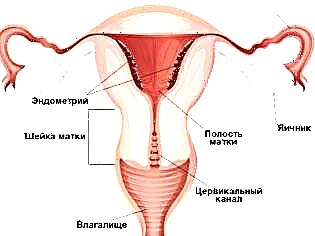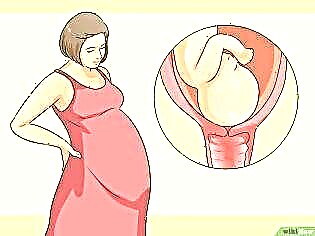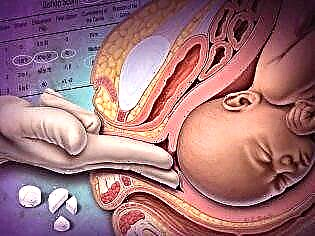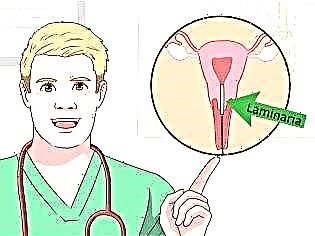
Preparing for childbirth is not only about buying cute baby things, equipping a sleeping place for your baby and collecting a bag for a maternity hospital. Preparation includes larger-scale activities aimed at creating the correct psychological mood for childbirth without fear and pain, for the physical fitness of all muscle groups.
Separately, attention is paid to preparing the cervix for childbirth, because it depends on it how quickly and easily the baby will be born. In this material we will talk about why the cervix is immature and how you can prepare it for the birth process.

Role in the generic process
Throughout the entire period of pregnancy, the cervix acts as a "locking device", tightly closing the uterine cavity. The uterus is a saccular organ that narrows just in the isthmus region.
The cervix is a round muscle, inside it is the cervical canal, which is securely closed by a lump of mucus (the so-called mucous plug) during the gestation period. Such safety measures were taken by nature itself to prevent infections, microbes, viruses from entering the uterine cavity where the child grows and develops. An almost sterile environment is formed inside the uterus.


As we approach childbirth, the body, under the influence of changes in hormonal levels, launches a chain of important processes in the female reproductive organ, which serves as a cozy house for the baby.
The tissues of the uterus begin to lose excess, excess nerve fibers so that pain during childbirth is naturally reduced. In the cells of the uterine tissue, the protein actomyosin is produced, which will provide them with contractility.
The placenta and pituitary gland of the expectant mother begin to produce oxytocin, a hormone that, after accumulating in maximum concentration, leads to the onset of full-fledged labor pains.


The cervix also begins to prepare. She will be assigned the main role - opening up to 10-12 centimeters. After the neck opens, attempts will begin and the baby will be born.
Usually the maturation process starts in the second half of the third trimester, it goes very gradually. At 38-39 weeks and at 39-40 weeks, the degree of maturity is assessed - the readiness of the cervix for childbirth. The neck is considered mature, which has shortened to 1-1.5 centimeters, softened enough to open normally when full-fledged labor pains begin.
If labor begins with an immature cervix, there is a good chance that dilation will be abnormal or not. This is dangerous, first of all, with a high probability of injury to the head and spine of the fetus, as well as ruptures of the cervix, the occurrence of massive bleeding, and the weakness of labor forces, in which an emergency cesarean section will be shown to a woman.


Immaturity and its causes
If a woman, shortly before the expected date of birth, hears from the doctor that her cervix is not ready for disclosure, “is not ripe”, not only the question arises of how to “ripen it - and it is desirable to do it as soon as possible”, but also a quite reasonable question - why others the cervix is already mature, but in this case, maturation does not meet the standards.
An immature cervix is considered, the length of which at 38-39 weeks of gestation is 2.5-3 centimeters or more, the consistency of the cervix is dense, softening does not occur, the cervical canal is closed, the cervical obstetrician's finger does not pass. The external pharynx, when not ready for childbirth, is not located in the central part, but is displaced upward or backward. All these signs can easily be established by a doctor in an antenatal clinic, where a woman comes for a scheduled appointment. To do this, he will need to conduct a vaginal gynecological examination with hands and mirrors.


The reasons why the cervix is not preparing for the upcoming disclosure may be different:
- various nervous factors (stress, fears, anxiety, unfavorable psychological and social environment in which pregnancy proceeds, unwillingness to give birth for some personal reasons);
- endocrine disorders (high synthesis of progesterone in the body, low levels of estrogen, oxytocin, some abnormalities in the thyroid gland);
- some anomalies in the structure of the uterus, cervix, genital tract;
- inflammatory process in the genital tract, ascending infection;
- excessive stretching of the cervix due to numerous previous births, the presence of scars on the cervix due to its birth ruptures in previous births;
- a history of abortion and medical curettage, any intrauterine manipulation that required artificial expansion of the cervix for the introduction of instruments;
- idiopathic (unexplained) causes.

Women with obesity, preeclampsia, and pregnant women with uterine fibroids are especially prone to disturbances in the processes of cervical maturation. Pathologically slowly, the cervix of the uterus matures when carrying a large fetus, as well as when diagnosed with polyhydramnios.
Women who lead a sedentary lifestyle during pregnancy, do not engage in feasible and permitted sports, do not do gymnastics to strengthen the perineum, refrain from sexual intercourse with a partner, usually are more often among those who have problems with the maturation of the cervix.
Immaturity is a diagnosis, but not a sentence. Both traditional medicine and traditional medicine have many ways to help the cervix prepare for an upcoming birth.

Exercises
To help soften and prepare the cervix at home, a woman needs to master a simple but very effective set of exercises developed by obstetrician Kegel. Gymnastics in his name is allowed for most pregnant women at the end of the first trimester, when the highest risks of not bearing a baby have passed.


It is recommended to devote about 10 minutes to gymnastics per day. Beforehand, it is imperative to check with the obstetrician-gynecologist who leads the pregnancy, whether it is possible for you to practice exercises to strengthen the pelvic floor, the muscles of the perineum and the lower segment of the uterus.
It is very convenient to do it - you can do it anywhere and at any time, because most of the effective exercises can be performed completely unnoticed by others - while watching a movie, in transport, in the kitchen while preparing dinner.
Kegel gymnastics will help not only prepare the cervix for childbirth, but also make the muscles of the perineum and birth canal more elastic, which will minimize the likelihood of tears in childbirth and the need for incisions.


What exercises you need to pay attention to:
- alternating squeezing and relaxation of the muscles of the vagina and anal sphincter;
- compression and relaxation of the vagina at different speeds;
- deep calm breaths, combined with strong compression and exhalation with a gradual relaxation of the muscles of the birth canal;
- lifting and circular rotation of the pelvis from a supine position on the floor, on a fitball;
- holding the tight vaginal muscles for as long as possible.
For each lesson, all the exercises do not need to be carried out at once, 2-3 techniques will be enough, which the woman will repeat in 8-10 minutes, you can take short breaks. At first it is quite difficult, but gradually the muscles of the perineum and birth canal become more and more strong, it becomes easier to perform the exercises.
In addition to the obvious advantages for preparing the birth canal, a woman after a few weeks of such sessions will pay attention to the fact that sex has become brighter, the sensations for her and her partner have intensified.
Together with the massage in the complex, massage of the external genital organs should be done. For him, you need to allocate only five minutes a day. Movements should be performed with an open palm and fingertips; it is better to pre-trim the manicure. For the massage, you can use neutral oils, such as Weleda Intimate Maternity Oil.

Medicines
Medicines for softening and shortening the cervix are chosen by the doctor. If the case is in excessive overstrain of the round muscle, then antispasmodic drugs are prescribed, for example, "No-Shpu". Usually, a two-week intake of an antispasmodic in tablets helps to soften the neck, if this does not help, the drug is injected already in a maternity hospital.
Almost all medication techniques for preparing the cervix for childbirth are used under the supervision of a doctor in a hospital setting. The only exceptions are the already mentioned "No-Shpa", candles "Buscopan" and "Papaverin". In a hospital setting, hormonal preparations in the form of gels, hormones injections can be used to stimulate cervical ripening. For preparation, estrogens and prostaglandins are used.
Kelp is a fairly popular method of quick preparation of the neck. Seaweed is sold in pharmacies in the form of very thin sticks. After the doctor inserts such a stick into the cervical canal, the algae begin to swell, expanding the cervix from the inside.
Women at the same time note some discomfort, pulling pain of a moderate nature and increased vaginal discharge.
It should be noted that all medications are prescribed exclusively if indicated, dosages are selected individually. If there is no effect, a decision can be made to perform a caesarean section, since spontaneous childbirth with an immature and unprepared cervix can pose a serious danger to the mother and fetus.


Folk remedies
There is an opinion among the people that regular sex helps to prepare the cervix for childbirth.
There is some truth in this, because sperm contains prostaglandins, which have a softening effect on the round muscle in the lower segment of the uterus. But sex in the later stages is not allowed for all pregnant women. It is imperative to discuss this "treatment" option with your doctor. And you certainly shouldn't have sex if amniotic fluid began to leak or there is a suspicion of that, as well as after the mucous plug begins to drain.

Among other methods, even great-grandmothers recommended paying attention to the rosehip. Its fruits are very useful for the expectant mother, including for the approach of childbirth. A water decoction is made from dried rose hips and taken first 50 ml on an empty stomach per day, and then 100-150 ml once a day.
Traditional medicine also recommends that women drink an aqueous infusion of raspberry leaves and strawberry fruits and leaves. Evening primrose oil also helps.


Movement is also useful - you can walk up and down the stairs (if there is no symphysitis), you can continue to do yoga, practice breathing exercises, every day, as you can, walk in the fresh air.
Household work (naturally, feasible and reasonable) also facilitates the process of cervical dilatation.

Reviews
Women who were faced with the need to help their own body prepare for childbirth say that a special diet helps a lot - meat is limited to twice a week, fish dishes come to replace it. Women recommend starting to adhere to such a diet at least a month before the expected date of birth.
Among the recommendations that women in labor give each other on thematic forums on the Internet, there are tips to collect matches from the floor in a squatting position, wash the floors with your hands, do a warm shower for the back and lower back, take a tablespoon of vegetable oil on an empty stomach in the morning.


A woman cannot independently check the readiness of the cervix, but often pregnant women at a later date do the so-called mammary readiness test. It will need a watch and a comfortable place to lie comfortably. The woman stimulates the nipples for a minute every three minutes. If from the beginning of such stimulation within 10 minutes the uterus tense (slightly "petrified") at least three times, they talk about a positive mammary test, that is, childbirth is just around the corner.

The specialist tells about the preparation of the cervix and the degrees of its maturity in the following video.



